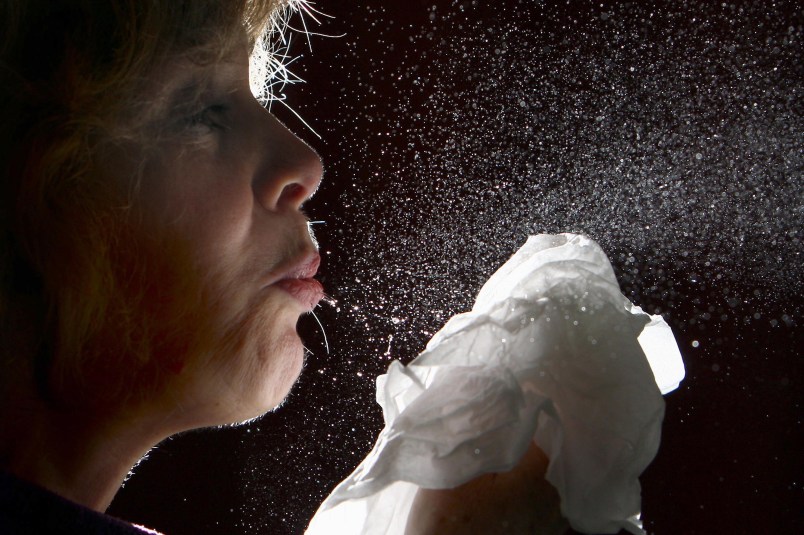BETHESDA, Md. (AP) — Forget being sneezed on: Government scientists are deliberately giving dozens of volunteers the flu by squirting the live virus straight up their noses.
It may sound bizarre, but the rare type of research is a step in the quest for better flu vaccines. It turns out that how the body fends off influenza remains something of a mystery.
“Vaccines are working, but we could do better,” said Dr. Matthew Memoli of the National Institutes of Health, who is leading the study that aims to infect up to 100 adults over the next year.
Wait a minute: Flu is sweeping the country, so why not just study the already sick? That wouldn’t let scientists measure how the immune system reacts through each step of infection, starting with that first exposure to the virus.
It’s not an experiment to be taken lightly. After all, the flu kills thousands of Americans a year. For safety, Memoli chose a dose that produces mild to moderate symptoms — and accepts only volunteers who are healthy and no older than 50.
And to avoid spreading the germs, participants must spend at least nine days quarantined inside a special isolation ward at the NIH hospital, their health closely monitored. They’re not released until nasal tests prove they’re no longer contagious.
The incentive: About $3,000 to compensate for their time.
“I received a very scolding email from my mother” about signing up, Daniel Bennett, 26, said with a grin.
“Their standards are so high, I don’t believe I’m in danger,” added Bennett, a restaurant worker from College Park, Md. “I don’t get sick that often.”
A masked and gloved Memoli had Bennett lie flat for about a minute.
“It will taste salty. Some will drip down the back of your throat,” Memoli said, before squeezing a syringe filled with millions of microscopic virus particles, floating in salt water, into each nostril.
Sure enough, a few days later Bennett had the runny nose and achiness of mild flu.
The best defense against influenza is a yearly vaccine, but it’s far from perfect. In fact, the vaccine is least effective in people age 65 and older — the group most susceptible to flu — probably because the immune system weakens with age.
Understanding how younger adults’ bodies fight flu may help scientists determine what the more vulnerable elderly are missing, clues to help develop more protective vaccines for everyone, Memoli explained.
Here’s the issue: The vaccine is designed to raise people’s levels of a particular flu-fighting antibody. It targets a protein that acts like the virus’ coat, called hemagglutinin — the “H” in H1N1, the strain that caused the 2009 pandemic and that is causing the most illness so far this winter, too.
But it’s not clear what antibody level is best to aim for — or whether a certain amount means you’re protected against getting sick at all, or that you’d get a mild case instead of a severe one.
“As mind-boggling as it is, we don’t know the answer to that,” said Dr. Anthony Fauci, chief of NIH’s National Institute of Allergy and Infectious Diseases. “We made some assumptions that we knew everything about flu.”
Just targeting hemagglutinin probably isn’t enough, Memoli added. Already, some people in his study didn’t get sick, despite remarkably low antibody levels, meaning something else must be protecting them.
Could it be antibodies against the “N” in flu’s name, the neuraminidase protein? Specific T cells that are activated to fight infection? Genes that switch on and off when a virus invades?
To begin finding out, Memoli first developed a laboratory-grown copy of the H1N1 flu strain and sprayed different amounts into volunteers’ noses until he found the right dose to trigger mild flu. He hopes eventually to test the harsher H3N2 strain, too.
Now he’s infecting two groups — people with low antibody levels and those with high levels. Some were recently vaccinated, and some weren’t. He’ll compare how sick they get, how long they’re contagious and how the immune system jumps into action.
Called a human challenge study, this kind of research hasn’t been performed with flu viruses in the U.S. for more than a decade, before scientists had ways as sophisticated to measure what happens.
“It’s all going to add up to a better understanding of what you need to have to be protected against the flu,” said Dr. John Treanor, a flu specialist at the University of Rochester Medical Center who is closely watching the work.
So far, Memoli’s patients are becoming contagious a day or two before they start feeling bad, one reason the flu spreads so easily. He sees a range of symptoms, from sniffles to a few days of moderate fever, fatigue and congestion.
Bennett’s flu was pretty mild, and he passed the time studying, watching TV and playing games with the four other study participants infected this month.
“All I had to do was read and watch movies, so it wasn’t that terrible,” Bennett said. “It was a really cool experience” to see how research is done.
Copyright 2014 The Associated Press. All rights reserved. This material may not be published, broadcast, rewritten or redistributed.






